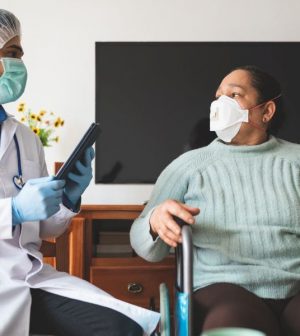- Navigating Your Midlife Crisis: Embracing New Possibilities
- City Raccoons Showing Signs of Domestication
- Mapping the Exposome: Science Broadens Focus to Environmental Disease Triggers
- One Week Less on Social Media Linked to Better Mental Health
- Your Brain Changes in Stages as You Age, Study Finds
- Some Suicide Victims Show No Typical Warning Signs, Study Finds
- ByHeart Formula Faces Lawsuits After Babies Sickened With Botulism
- Switch to Vegan Diet Could Cut Your Greenhouse Gas Emissions in Half
- Regular Bedtime Does Wonders for Blood Pressure
- Dining Alone Could Mean Worse Nutrition for Seniors
Health Care Workers More Likely to Catch COVID at Home, Not Workplace

Health care workers are more likely to catch COVID-19 at home or in their community than on the job, a new study finds.
“The news is reassuring in that it shows the measures taken are working to prevent infections from spreading in health care facilities,” said study co-author Dr. Anthony Harris. He’s professor of epidemiology and public health at the University of Maryland School of Medicine, in Baltimore.
For the study, researchers analyzed survey data from nearly 25,000 health care providers in Baltimore, Atlanta and Chicago. They found that the strongest risk factor for COVID-19 was known exposure to someone in the community who tested positive for the disease.
Another strong risk factor: living in a ZIP code with a high rate of COVID-19, according to the report published online March 10 in JAMA Network Open.
Harris said vaccination of health care workers should remain a priority because of continual exposures on the job.
“There is also an urgent need to keep health care providers healthy so they can care for sick patients and reduce the risk of transmitting the virus to vulnerable patients,” he said in a university news release.
Surprisingly, factors presumed to contribute most to the risk of infection among health care providers (including caring for COVID-19 patients) were not associated with increased risk in this study, according to co-author Dr. Sujan Reddy. He’s an infectious disease specialist at the U.S. Centers for Disease Control and Prevention.
The researchers said they were unable to gauge the level of effectiveness of protective equipment (such as N95 respirators, gowns, masks and face shields), because infection control practices differed at sites included in the study.
The investigators were also unable to determine whether certain infection controls, such as frequent disinfection of surfaces in exam rooms, were better than others in preventing the spread of the new coronavirus.
According to Dr. E. Albert Reece, professor and dean at the University of Maryland School of Medicine, “As front-line and support staff at hospitals and health systems continue to tirelessly battle COVID-19, they can draw reassurance in this important research finding that the infection control measures in place protected themselves and their families.”
More information
The U.S. Centers for Disease Control and Prevention has more on COVID-19.
SOURCE: University of Maryland School of Medicine, news release, March 10, 2021
Source: HealthDay
Copyright © 2025 HealthDay. All rights reserved.










